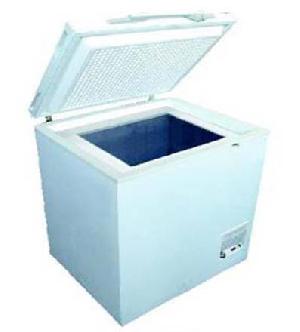Freezers
Freezer units are used in households and in industry and commerce. Food stored at or below 0 °F will be safe indefinitely.
Most household freezers maintain temperatures from -10 to 0 °F (-23 to -18 °C), although some freezer-only units can achieve −30 °F (−34 °C), and lower. Refrigerators generally do not achieve lower than -10 °F (-23 °C), since the same coolant loop serves both compartments: Lowering the freezer compartment temperature excessively causes difficulties in maintaining above-freezing temperature in the refrigerator compartment. Domestic freezers can be included as a separate compartment in a refrigerator, or can be a separate appliance. Domestic freezers are generally upright units resembling refrigerators, or chests. Many upright modern freezers come with an ice dispenser built into their door.
Commercial freezer units, which go by many other names, were in use for almost 40 years prior to the common home models. They used gas systems such as anhydrous ammonia(R-717) or
sulfur dioxide(R-764), which occasionally leaked, making them unsafe for home use and industrial purposes. Practical household refrigerators were introduced in 1915 and gained wider acceptance in the United States in the 1930s as prices fell and non-toxic, non-flammable synthetic refrigerants such as
Freon-12(R-12) were introduced, however R-12 damaged the ozone layer,causing governments to issue a ban on its use in new refrigerators and air-conditioning systems in 1994. The less harmful replacement for R-12, R-134a (tetrafluoroethane), has only been in common use since 1990, but R-12 is still found in many old systems today.
